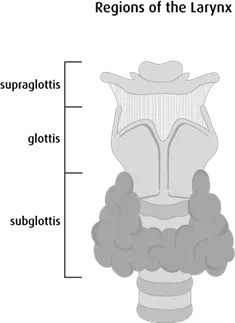Stages of laryngeal cancer
Staging describes or classifies a cancer based on how much cancer there is in the body and where it is when first diagnosed. This is often called the extent of cancer. Information from tests is used to find out the size of the tumour, which parts of the organ have cancer, whether the cancer has spread from where it first started and where the cancer has spread. Your healthcare team uses the stage to plan treatment and estimate the outcome (your prognosis).
The most common staging system for laryngeal cancer is the TNM system. For laryngeal cancer there are 5 stages – stage 0 followed by stages 1 to 4. Often the stages 1 to 4 are written as the Roman numerals I, II, III and IV. Generally, the higher the stage number, the more the cancer has spread. Talk to your doctor if you have questions about staging.
Some doctors may also use the following terms when discussing laryngeal cancer:
- Stage 0 laryngeal cancer is also called
carcinoma in situ . The cancer is only in the inner lining of the larynx. - Early stage laryngeal cancer includes stages 1 and 2.
- Locally advanced laryngeal cancer means stage 3.
- Advanced stage laryngeal cancer means stage 4.
Laryngeal cancer staging is very complicated since it is based on where the cancer starts in the larynx. There are unique descriptions for stages 1, 2 and 3 for cancer that starts above the vocal cords, in the vocal cords and below the vocal cords in the larynx. The stage 4 description is the same regardless of where the cancer started. Find out more about staging cancer.

Cancer that starts above the vocal cords (supraglottis)
The following is staging for cancer that starts in the top part of the larynx above the vocal cords (called the supraglottis).
Stage 1
The tumour is only within the subglottis.
Stage 2
The tumour has grown into the vocal cords. The vocal cords may not move normally.
Stage 3
Stage 3 can be one of the following:
- The tumour is only within the larynx, and the vocal cords can’t move.
- The cancer has spread to 1 nearby lymph node on the same side of the neck as the tumour. This lymph node is not larger than 3 cm.
Cancer that starts in the vocal cords (glottis)
The following is staging for cancer that starts in the middle part of the larynx, which contains the vocal cords (called the glottis).
Stage 1
The tumour is only within the vocal cords.
Stage 2
The tumour has grown into the top of the larynx above the vocal cords, the bottom of the larynx below the vocal cords or both. The vocal cords don’t move normally.
Stage 3
Stage 3 can be one of the following:
- The tumour is only within the larynx, and the vocal cords can’t move. Or the tumour has grown into areas near the larynx, and the vocal cords may not move.
- The cancer has spread to 1 nearby lymph node on the same side of the neck as the tumour. This lymph node is not larger than 3 cm.
Cancer that starts below the vocal cords (subglottis)
The following is staging for cancer that starts in the bottom part of the larynx below the vocal cords (called the subglottis).
Stage 1
The tumour is only within the subglottis.
Stage 2
The tumour has grown into the vocal cords. The vocal cords may not move normally.
Stage 3
Stage 3 can be one of the following:
- The tumour is only within the larynx, and the vocal cords can't move.
- The cancer has spread to 1 nearby lymph node on the same side of the neck as the tumour. This lymph node is not larger than 3 cm.
Stage 4 laryngeal cancer
Stage 4 laryngeal cancer is similar for all cancers that start in the larynx.
Stage 4 can be divided into stages 4A, 4B or 4C depending on:
- which nearby areas the tumour has grown into
- the number and size of the lymph nodes with cancer
- if the cancer has grown outside lymph nodes (extranodal extension)
- whether the lymph nodes are on the same or opposite side of the neck as the tumour, or on both sides of the neck
- if the cancer has spread to other parts of the body farther from the larynx (called distant metastasis)
Recurrent laryngeal cancer
Recurrent laryngeal cancer means that the cancer has come back after it has been treated. You will have more tests to find out where the cancer has come back or spread to. If it comes back in the same place that the cancer first started, it’s called local recurrence. If it comes back in tissues or lymph nodes close to where it first started, it’s called regional recurrence. It can also recur in another part of the body. This is called distant metastasis or distant recurrence.
